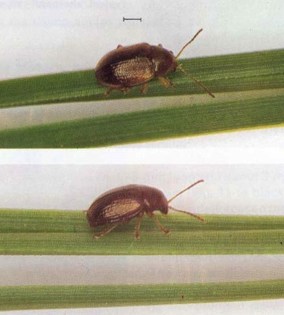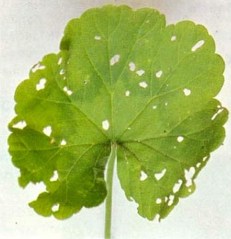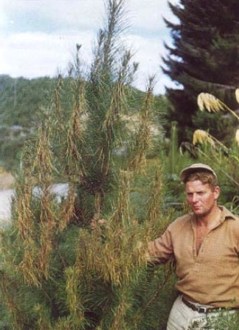PESTS AND DISEASES OF FORESTRY IN NEW ZEALAND
Bronze beetle, Eucolaspis brunnea
Scion is the leading provider of forest-related knowledge in New Zealand
Formerly known as the Forest Research Institute, Scion has been a leader in research relating to forest health for over 50 years. The Rotorua-based Crown Research Institute continues to provide science that will protect all forests from damage caused by insect pests, pathogens and weeds. The information presented below arises from these research activities.
Forest and Timber Insects in New Zealand No. 49: Bronze beetle.
Revised 2009
Based on M.K. Kay (1980)
Insect: Eucolaspis brunnea (F.) (Coleoptera: Chrysomelidae)

Fig. 1 - Top view and side view of bronze beetle (on radiata pine needle).
The line shows natural length.
Type of injury
Bronze beetles eat foliage of the host plants, but feeding tends to be haphazard and discontinuous. On broad-leaved plants they chew from the lower surface of the leaf, penetrate to the upper side, and produce a "shot-hole" effect (Fig. 2). On conifers many lightly attacked needles are effectively severed for the undamaged outer portion rapidly withers and browns. A large number of such needles gives the tree a scorched appearance (Fig. 3).
Larvae live in the soil and feed on the roots of grasses, but although sometimes present in large numbers the damage they do is slight.
Distribution
The bronze beetle is a native insect which occurs throughout New Zealand.
Hosts
The beetles feed on a wide range of plants including native and exotic broad-leaved and coniferous trees.

Fig. 2 - Bronze beetles attack the foliage of many kinds of plant. This geranium leaf shows the typical "shot-hole"-type damage.

Fig. 3 - Damage by bronze beetle to 3-year old radiata pine.
Economic importance
In forestry, damage is most often recorded from stands of Pinus radiata (radiata pine) aged between one and five years, where attacks can occasionally result in moderate localised defoliation. High populations usually last no more than one season, and pine trees soon outgrow any effect of defoliation by this insect.
The beetle is usually only important in fruit orchards where severe defoliation may affect fruit production, and the blemishes produced through beetles chewing the young apples will detract from the value of the crop at maturity.
Description, life history, and habits
Eucolaspis brunnea is usually recorded as the beetle responsible for this damage. However, there are 20 or more similar species of beetle which can make identification difficult, but although little is known of their distribution, their life histories are undoubtedly very similar.
Eucolaspis brunnea adults are 4-5 mm long and about 3 mm wide. They are oval and rather shiny, varying from brown (Fig. 1) to black. The head is partially sunk into the thorax and has two rather widely spaced prominent black eyes. The threadlike antennae, each with 11 distinctly jointed segments, are about as long as the elytra (wing cases). The thorax is pitted and often has two greenish-black spots. The elytra are broader than the thorax, convex, and extend beyond the end of the abdomen. They are irregularly pitted and often darken to green-black along the mid-line. The yellow-brown legs are robust for jumping and burrowing, and end in strong two-pronged claws.
Fully grown larvae are about 5 mm long and 2 mm in diameter, stout, and somewhat curved, with a slight taper towards the front. The head is light yellow tinged with brown and the body soft and white. Short distinct legs and the shiny hard upper surface of the segment immediately behind the head distinguish them from weevil larvae (which are legless), and grass grub larvae which have legs but not the hardened segment behind the head.
The pupae are creamy-white and have a well developed spine on each side of the second abdominal segment, and two pairs of spines on the end of the abdomen. The femora of the middle legs each end in a spine.
Adult females prefer to lay eggs in firm dry soil. The eggs are less than 1 mm in length and turn from white to yellow during development. They are sometimes laid singly but more often in batches of 3 to 14, within earthen cells 10-30 mm below the soil surface. Active larvae emerge from the eggs after about three weeks. Larvae pass the winter hibernating in individual earthen cells 25-200 mm underground. In early spring they become active again and when fully grown form cells near the surface in which to pupate. Pupation takes about three weeks. The adult flight period lasts from October to March, reaching a peak in November and December. The beetles are especially active on hot sunny days, and have lived for up to eight weeks in captivity. If disturbed they jump vigorously off the plant, and for this reason are sometimes called "flea beetles".
Control
Chemical control has not been necessary in forests but if required in nurseries, or for specimen trees, a synthetic pyrethroid or other contact insecticide can be used to control the adults.
Where appropriate, control by cultivation of the soil is useful, especially during the early summer. The ground is made less attractive for egg laying, and grass (the larval food) is
removed.
Some natural control of larvae in the soil may be effected by the predatory larvae of ground beetles and robber flies.
Bibliography
Kay, M.K. 1980: Eucolaspis brunnea (Fabricius) (Coleoptera: Chrysomelidae). Bronze beetle. New Zealand Forest Service, Forest and Timber Insects in New Zealand No. 49.
Lysaght, A.M. 1930: Bronze beetle research. New Zealand Department of Scientific and Industrial Research, Bulletin 25. 32 p.
This information is intended for general interest only. It is not intended to be a substitute for specific specialist advice on any matter and should not be relied on for that purpose. Scion will not be liable for any direct, indirect, incidental, special, consequential or exemplary damages, loss of profits, or any other intangible losses that result from using the information provided on this site.
(Scion is the trading name of the New Zealand Forest Research Institute Limited.)



